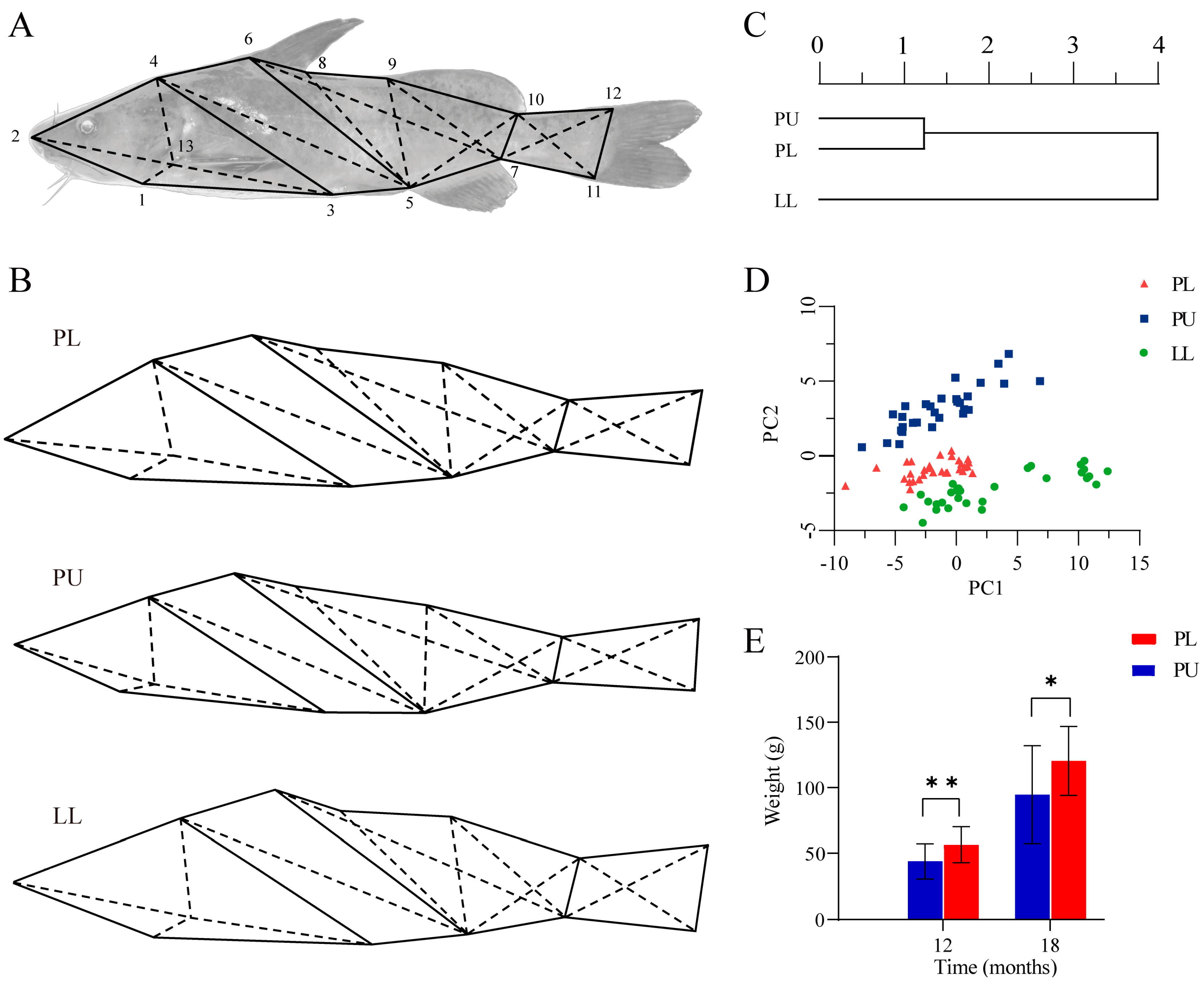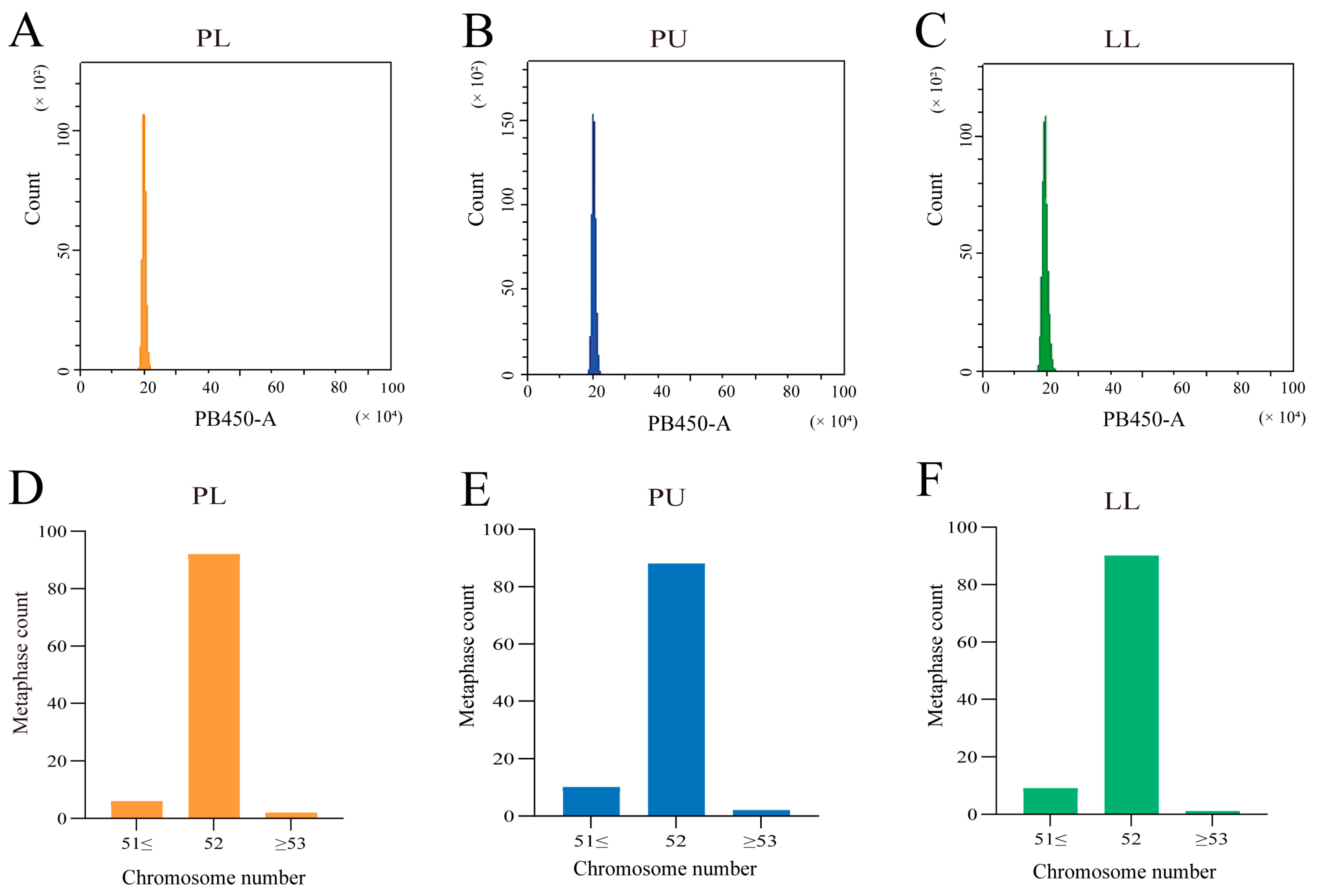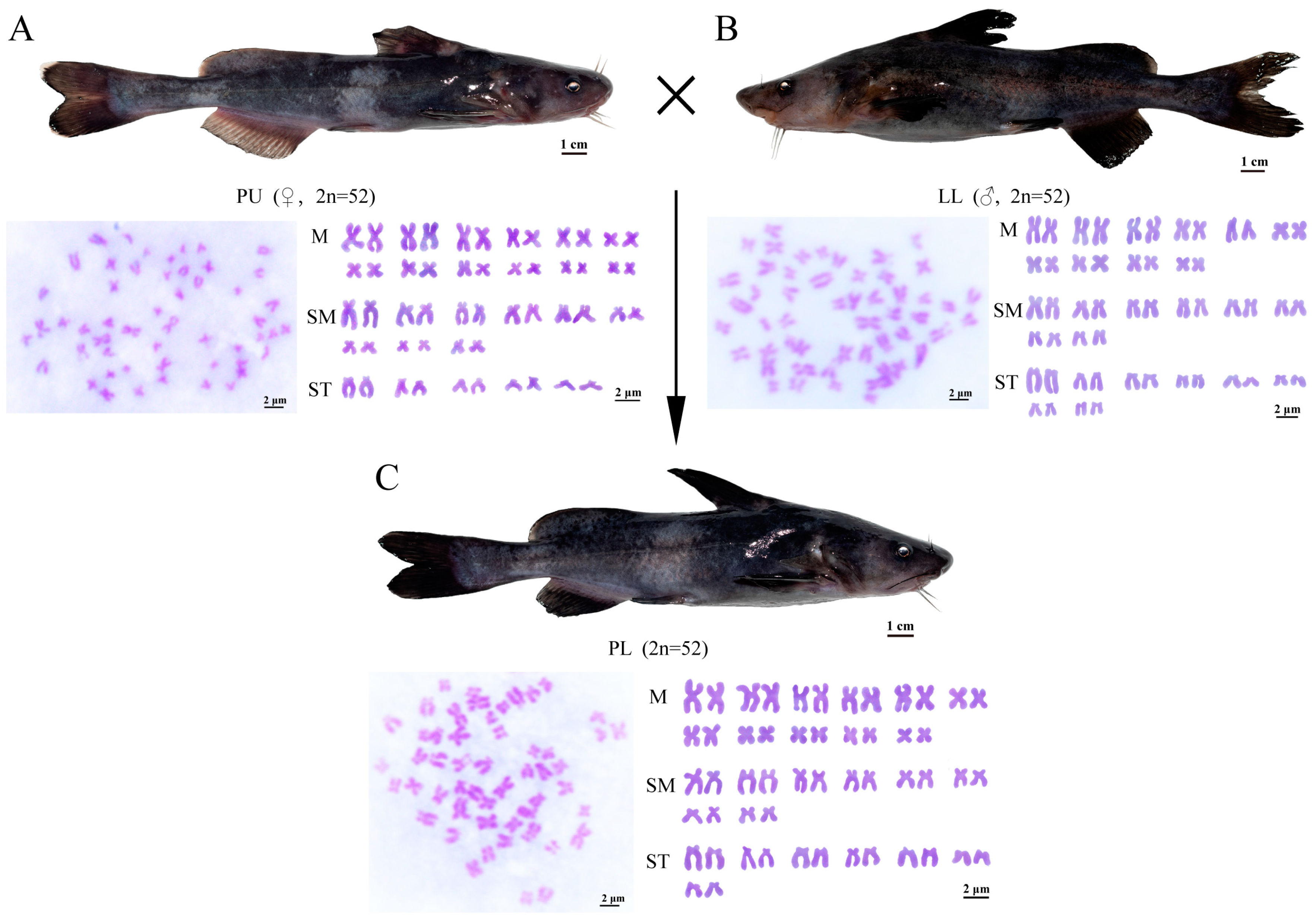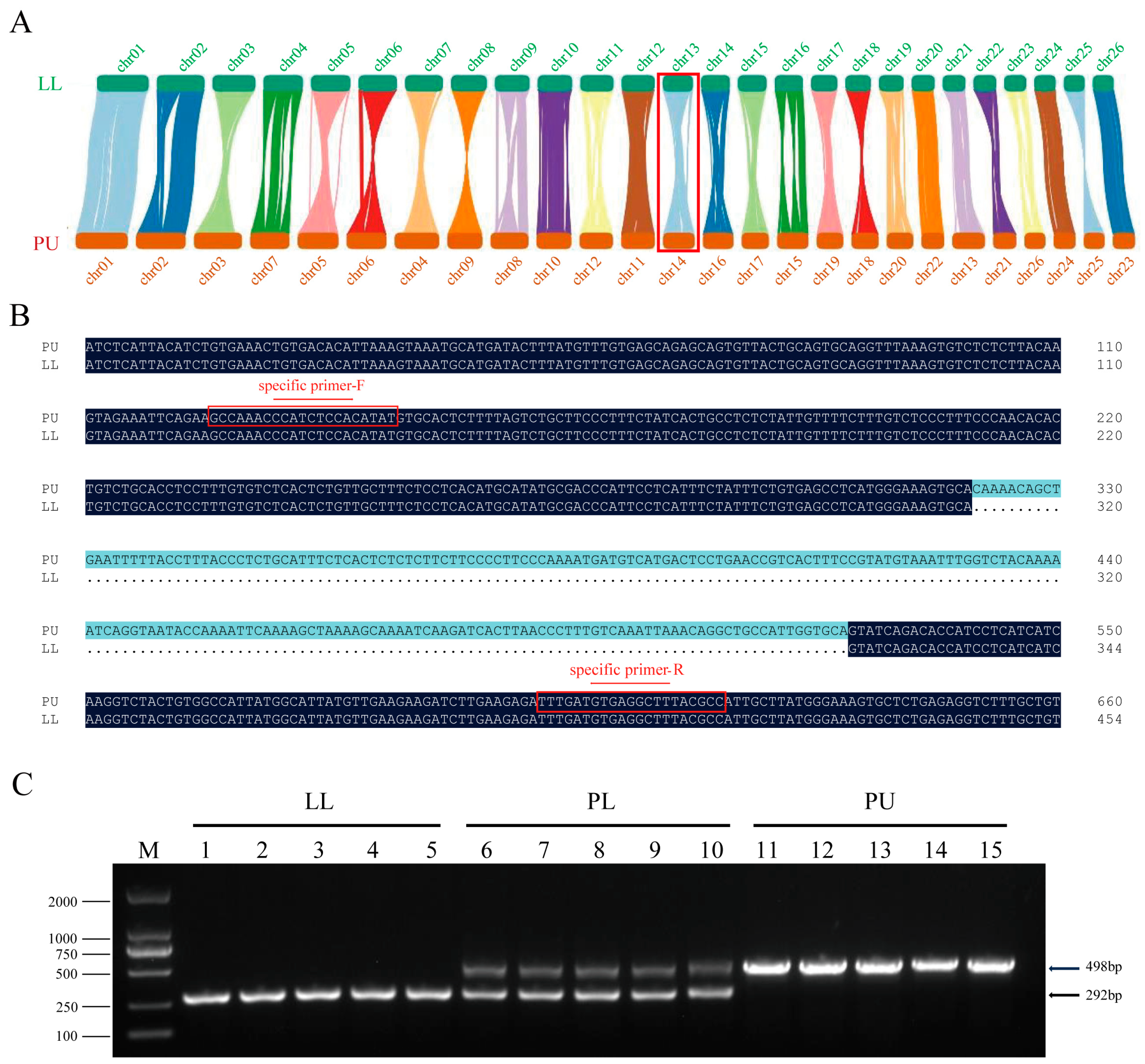Growth Superiority and Genetic Characterization of the Hybrid from Female Ussuri Catfish (Pseudobagrus ussuriensis) and Male Longsnout Catfish (Leiocassis longirostris)
Simple Summary
Abstract
1. Introduction
2. Materials and Method
2.1. Animals and Ethics Statement
2.2. In Vitro Reproduction and Progeny Rearing
2.3. Measurement of Morphological Indicators
2.4. Assessment of Growth Performance
2.5. Measurement of DNA Content via Flow Cytometry
2.6. Preparation of Chromosome Spreads
2.7. Comparison of Mitochondrial DNA Control Region
2.8. Development and Validation of Species-Specific DNA Marker
3. Results
3.1. Fertilization Rates and Hatching Rates
3.2. Morphological Differences Between the PL Hybrid and Their Parents
3.3. Growth Superiority of the PL Hybrid over the Maternal PU
3.4. DNA Contents and Chromosome Comparisons of the PL Hybrid and Their Parents
3.5. Identical Mitochondrial DNA of the PL Hybrid with Maternal PU
3.6. Specific Marker Development and PL Hybrid Identification
4. Discussion
5. Conclusions
Author Contributions
Funding
Institutional Review Board Statement
Informed Consent Statement
Data Availability Statement
Conflicts of Interest
References
- Guan, W.Z.; Qiu, G.F.; Liu, F. Transcriptome Analysis of the Growth Performance of Hybrid Mandarin Fish after Food Conversion. PLoS ONE 2020, 15, e0240308. [Google Scholar] [CrossRef]
- Cai, L.; Tong, F.; Tang, T.; Ao, Z.; Wei, Z.; Yang, F.; Shu, Y.; Liu, S.; Mai, K. Comparative Evaluation of Nutritional Value and Flavor Quality of Muscle in Triploid and Diploid Common Carp: Application of Genetic Improvement in Fish Quality. Aquaculture 2021, 541, 736780. [Google Scholar] [CrossRef]
- Guo, H.H.; Zheng, G.D.; Wu, C.B.; Jiang, X.Y.; Zou, S.M. Comparative Analysis of the Growth Performance and Intermuscular Bone Traits in F1 Hybrids of Black Bream (Megalobrama terminalis) (♀) × topmouth Culter (Culter alburnus) (♂). Aquaculture 2018, 492, 15–23. [Google Scholar] [CrossRef]
- Liu, Q.; Liu, J.; Yuan, L.; Li, L.; Tao, M.; Zhang, C.; Qin, Q.; Chen, B.; Ma, M.; Tang, C.; et al. The Establishment of the Fertile Fish Lineages Derived from Distant Hybridization by Overcoming the Reproductive Barriers. Reproduction 2020, 159, R237–R249. [Google Scholar] [CrossRef] [PubMed]
- Kamal, A.H.M.M.; Mair, G.C. Salinity Tolerance in Superior Genotypes of Tilapia, Oreochromis niloticus, Oreochromis mossambicus and Their Hybrids. Aquaculture 2005, 247, 189–201. [Google Scholar] [CrossRef]
- San, L.Z.; Liu, B.S.; Liu, B.; Zhu, K.C.; Guo, L.; Guo, H.Y.; Zhang, N.; Jiang, S.G.; Zhang, D.C. Genome-Wide Association Study Reveals Multiple Novel SNPs and Putative Candidate Genes Associated with Low Oxygen Tolerance in Golden Pompano Trachinotusovatus (Linnaeus 1758). Aquaculture 2021, 544, 737098. [Google Scholar] [CrossRef]
- Wang, H.Y.; Lin, G.; Zhou, J.; Zong, Y.Q.; Ning, X.H.; Wang, T.; Yin, S.W.; Zhang, K.; Ji, J. The Hybrid Pelteobagrus fulvidraco (♀) × Leiocassis longirostris (♂) Exhibits Improved Trait on Hypoxia-Tolerance. Aquaculture 2023, 562, 738859. [Google Scholar] [CrossRef]
- Zhang, J.J.; Pei, X.Y.; Wu, Z.W.; Li, J.; Wang, T.; Yin, S.W. A Comparative Study of Immune Response between Hybrid Yellow Catfish “Huangyou-1” and Its Parental Populations after Challenge with Aeromonas hydrophila or Edwardsiella ictaluri. Aquac. Int. 2019, 27, 859–873. [Google Scholar] [CrossRef]
- Gui, J.F.; Zhou, L.; Li, X.Y. Rethinking Fish Biology and Biotechnologies in the Challenge Era for Burgeoning Genome Resources and Strengthening Food Security. Water Biol. Secur. 2022, 1, 100002. [Google Scholar] [CrossRef]
- Gui, J.F. Chinese Wisdom and Modern Innovation of Aquaculture. Water Biol. Secur. 2024, 3, 100271. [Google Scholar] [CrossRef]
- Duan, Z.P.; Chen, Y.F.; Li, X.Q.; Cao, K.L.; Zhao, Y.; Yang, X.; Sun, Z.C.; Leng, X.J. An Evaluation of Yeast Culture in Diet of Hybrid Snakehead (Channa argus ♂ × Channa maculate ♀): Growth, Serum Biochemical Parameters, Intestinal Histology and Microorganisms. Aquac. Rep. 2023, 32, 101711. [Google Scholar] [CrossRef]
- Dunham, R.A.; Elaswad, A. Catfish Biology and Farming. Annu. Rev. Anim. Biosci. 2017, 6, 305–325. [Google Scholar] [CrossRef]
- Pan, Z.J.; Zhu, C.K.; Wang, H.; Chang, G.L.; Ding, H.Y.; Qiang, X.G.; Yu, X.S. Induction of Meiotic Gynogenesis in Bagrid Catfish (Pseudobagrus ussuriensis) with Homologous Sperm and Its Confirmation for Female Homogamety. Aquac. Res. 2017, 48, 5659–5665. [Google Scholar] [CrossRef]
- Pan, Z.J.; Zhu, C.K.; Chang, G.L.; Wu, N.; Ding, H.Y.; Wang, H. Differential Expression Analysis and Identification of Sex-Related Genes by Gonad Transcriptome Sequencing in Estradiol-Treated and Non-Treated Ussuri Catfish Pseudobagrus ussuriensis. Fish Physiol. Biochem. 2021, 47, 565–581. [Google Scholar] [CrossRef] [PubMed]
- Wang, Y.Y.; Yu, S.L.; Ma, G.J.; Chen, S.B.; Shi, Y.; Yang, Y.H. Comparative Study of Proximate Composition and Amino Acid in Farmed and Wild Pseudobagrus ussuriensis Muscles. Int. J. Food Sci. Technol. 2014, 49, 983–989. [Google Scholar] [CrossRef]
- Bu, X.Y.; Chen, A.J.; Lian, X.Q.; Chen, F.Y.; Zhang, Y.; Muhammad, I.; Ge, X.P.; Yang, Y.H. An Evaluation of Replacing Fish Meal with Cottonseed Meal in the Diet of Juvenile Ussuri Catfish Pseudobagrus ussuriensis: Growth, Antioxidant Capacity, Nonspecific Immunity and Resistance to Aeromonas hydrophila. Aquaculture 2017, 479, 829–837. [Google Scholar] [CrossRef]
- Shen, T.; He, X.; Lei, M.; Wang, J.; Li, X.; Li, J. Cloning and Structure of a Histocompatibility Class IIA Gene (Lelo-DAA) in Chinese Longsnout Catfish (Leiocassis longirostris). Genes Genom. 2014, 36, 745–753. [Google Scholar] [CrossRef]
- Dai, S.M.; Zhou, Y.L.; Guo, X.F.; Liu, M.; Wang, T.; Li, Z.; Han, D.; Mei, J.; Wang, Z.W.; Gui, J.F. Sex-Specific Markers Developed by Genome-Wide 2b-RAD Sequencing Confirm an XX/XY Sex Determination System in Chinese Longsnout Catfish (Leiocassis longirostris). Aquaculture 2022, 549, 737730. [Google Scholar] [CrossRef]
- Luo, H.; Li, Y.; Zheng, S.; Zhou, J.; Zou, X.; Li, C.; Ye, H.; Li, Z.; Zhou, C.; Lv, G.; et al. Identification of Male Sex-Specific Markers Using Genome Re-Sequencing in the Chinese Longsnout Catfish Leiocassis longirostris. Aquaculture 2022, 558, 738392. [Google Scholar] [CrossRef]
- Mou, C.Y.; Li, Y.; Zhou, J.; Li, Q.; Zhou, B.; Wei, Z.; Luo, H.; Ke, H.Y.; Duan, Y.L.; Zhai, W.T.; et al. Genome-Wide Association Study Reveals Growth-Related Markers and Candidate Genes for Selection in Chinese Longsnout Catfish (Leiocassis longirostris). Aquaculture 2022, 560, 738513. [Google Scholar] [CrossRef]
- Wang, H. Preliminary Studies on Cross-Breeding of Pelteobagrus fulvidraco and Leiocassis longirostris. Master’s Thesis, Nanjing Normal University, Nanjing, China, 2021. [Google Scholar] [CrossRef]
- Wang, M.H.; Cai, Y.X.; Chen, X.H.; Qin, Q.; Chen, Y.M.; Zhong, L.Q.; Bian, W.J.; Zhang, M.S. Comparison of Growth Performance of Hybrid Offspring from Pseudobagrus ussuriensis and Pelteobagrus vachelli Crosses and Self-Crosses. J. Aquat. Sci. 2013, 32, 50–54. [Google Scholar] [CrossRef]
- Qiu, C.F.; Wang, B.; Yu, X.S. Experimental Breeding and Culture of Pseudobagrus ussuriensis × Pelteobagrus fulvidraco Fry. J. Sci. Technol. Inf. 2009, 4, 314. [Google Scholar] [CrossRef]
- Ou, M.; Zhao, J.; Luo, Q.; Hong, X.Y.; Zhu, X.P.; Liu, H.Y.; Chen, K.C. Characteristics of Hybrids Derived from Channa argus ♀ × Channa maculata ♂. Aquaculture 2018, 492, 349–356. [Google Scholar] [CrossRef]
- Crivelli, A.J.; Dupont, F. Biometrical and Biological Features of Alburnus alburnus × Rutilus rubilio Natural Hybrids from Lake Mikri Prespa, Northern Greece. J. Fish Biol. 1987, 31, 721–733. [Google Scholar] [CrossRef]
- Lu, M.; Li, X.Y.; Li, Z.; Du, W.X.; Zhou, L.; Wang, Y.; Zhang, X.J.; Wang, Z.W.; Gui, J.F. Regain of Sex Determination System and Sexual Reproduction Ability in a Synthetic Octoploid Male Fish. Sci. China Life Sci. 2021, 64, 77–87. [Google Scholar] [CrossRef] [PubMed]
- Zhu, H.P.; Gui, J.F. Identification of Genome Organization in the Unusual Allotetraploid Form of Carassius auratus gibelio. Aquaculture 2007, 265, 109–117. [Google Scholar] [CrossRef]
- Levan, A.; Fredga, K.; Sandberg, A.A. Nomenclature For Centromeric Position Chromosomes. Hereditas 1964, 52, 201–220. [Google Scholar] [CrossRef]
- Ahti, P.A.; Kuparinen, A.; Uusi-Heikkilä, S. Size Does Matter the Eco-Evolutionary Effects of Changing Body Size in Fish. Environ. Rev. 2020, 28, 311–324. [Google Scholar] [CrossRef]
- Myers, E.M.V.; Anderson, M.J.; Eme, D.; Liggins, L.; Roberts, C.D. Changes in Key Traits versus Depth and Latitude Suggest Energy-Efficient Locomotion, Opportunistic Feeding and Light Lead to Adaptive Morphologies of Marine Fishes. J. Anim. Ecol. 2020, 89, 309–322. [Google Scholar] [CrossRef] [PubMed]
- Park, J.Y.; Kim, Y.H.; Bang, I.C. Comparison of Morphological Characteristics and Its Parent Species Hybrid Grouper between an Epinephelus moara ♀ and E. lanceolatus ♂. Korean J. Fish. Aquat. Sci. 2020, 53, 572–576. [Google Scholar] [CrossRef]
- Zhang, C.; Jacques, K.J.; Zhang, S.; Xu, S.L.; Wang, Y.J.; Wang, D.L. Analyses of Growth Performance and Realized Heritability of Pampus argenteus in a Breeding Program in China. Front. Mar. Sci. 2022, 9, 935924. [Google Scholar] [CrossRef]
- Nazrul, K.M.S.; Mamun, N.; Sarker, B.S.; Tonny, U.S. Morphological variability of the 11th generation strain of nile tilapia, (Oreochromis niloticus) and traditional genetically improved farmed tilapia. J. Bangladesh Agric. Univ. 2011, 9, 345–349. [Google Scholar] [CrossRef]
- Wu, Q.W.; Wu, Z.H.; Wang, L.J.; Lu, Y.L.; Bi, W.J.; Zhou, D.D.; Wang, L.; Peng, Z.Z.; You, F. Comparative Study on Growth Performance and Morphological Characteristics of the Meio- and Mito-Gynogenesis Olive Flounder (Paralichthys olivaceus). Aquaculture 2021, 535, 736387. [Google Scholar] [CrossRef]
- Solem, Ø.; Berg, O.K.; Kjøsnes, A.J. Inter- and Intra-Population Morphological Differences between Wild and Farmed Atlantic salmon Juveniles. J. Fish Biol. 2006, 69, 1466–1481. [Google Scholar] [CrossRef]
- Strauss, R.E.; Bookstein, F.L. The Truss: Body Form Reconstructions in Morphometrics. Syst. Zool. 1982, 31, 113–135. [Google Scholar] [CrossRef]
- Lu, M.; Zhang, Q.C.; Zhu, Z.Y.; Peng, F.; Li, Z.; Wang, Y.; Li, X.Y.; Wang, Z.W.; Zhang, X.J.; Zhou, L.; et al. An Efficient Approach to Synthesize Sterile Allopolyploids through the Combined Reproduction Mode of Ameiotic oogenesis and Sperm-Egg Fusion in the Polyploid Carassius Complex. Sci. Bull. 2023, 68, 1038–1050. [Google Scholar] [CrossRef] [PubMed]
- Lu, M.; Zhou, L.; Gui, J.F. Evolutionary Mechanisms and Practical Significance of Reproductive Success and Clonal Diversity in Unisexual Vertebrate Polyploids. Sci. China Life Sci. 2024, 67, 449–459. [Google Scholar] [CrossRef]
- Krasnovyd, V.; Vetešník, L.; Šimková, A. Distribution of Host-Specific Parasites in Hybrids of Phylogenetically Related Fish: The Effects of Genotype Frequency and Maternal Ancestry? Parasites Vectors 2020, 13, 402. [Google Scholar] [CrossRef] [PubMed]
- Šimková, A.; Vojtek, L.; Halačka, K.; Hyršl, P.; Vetešník, L. The Effect of Hybridization on Fish Physiology, Immunity and Blood Biochemistry: A Case Study in Hybridizing Cyprinus carpio and Carassius gibelio (Cyprinidae). Aquaculture 2015, 435, 381–389. [Google Scholar] [CrossRef]
- Ren, L.; Zhang, H.; Luo, M.X.; Gao, X.; Cui, J.L.; Zhang, X.Y.; Liu, S.J. Heterosis of Growth Trait Regulated by DNA Methylation and MiRNA in Allotriploid Fish. Epigenetics Chromatin 2022, 15, 19. [Google Scholar] [CrossRef]
- Sun, Y.; Huang, Y.; Hu, G.J.; Zhang, X.H.; Ruan, Z.Q.; Zhao, X.M.; Guo, C.Y.; Tang, Z.J.; Li, X.F.; You, X.X.; et al. Comparative Transcriptomic Study of Muscle Provides New Insights into the Growth Superiority of a Novel Grouper Hybrid. PLoS ONE 2016, 11, e0168802. [Google Scholar] [CrossRef] [PubMed]
- Torrans, L.; Ott, B. Effect of Grading Fingerling Hybrid Catfish (♀ Channel catfish × ♂ Blue catfish) on Growth, Production, Feed Conversion, and Food Fish Size Distribution. N. Am. J. Aquac. 2018, 80, 187–192. [Google Scholar] [CrossRef]
- Wang, H.; Bruce, T.J.; Su, B.; Li, S.; Dunham, R.A.; Wang, X. Environment-Dependent Heterosis and Transgressive Gene Expression in Reciprocal Hybrids between the Channel Catfish Ictalurus Punctatus and the Blue Catfish Ictalurus furcatus. Biology 2022, 11, 117. [Google Scholar] [CrossRef] [PubMed]
- Gu, H.R.; Wan, Y.F.; Yang, Y.; Ao, Q.; Cheng, W.L.; Deng, S.H.; Pu, D.Y.; He, X.F.; Jin, L.; Wang, Z.J. Genetic and morphology analysis among the pentaploid F1 hybrid fishes (Schizothorax wangchiachii ♀ × Percocypris pingi ♂) and their parents. Animal 2019, 13, 2755–2764. [Google Scholar] [CrossRef]
- Zhang, W.Z.; Xiong, X.M.; Zhang, X.J.; Wan, S.M.; Guan, N.N.; Nie, C.H.; Zhao, B.W.; Der Hsiao, C.; Wang, W.M.; Gao, Z.X. Mitochondrial Genome Variation after Hybridization and Differences in the First and Second Generation Hybrids of Bream Fishes. PLoS ONE 2016, 11, e0158915. [Google Scholar] [CrossRef]
- Li, Z.T.; Tian, Y.S.; Cheng, M.L.; Wang, L.N.; Zhang, J.J.; Wu, Y.P.; Pang, Z.F.; Ma, W.H.; Zhai, J.M. The Complete Mitochondrial Genome of the Hybrid Grouper Epinephelus moara (♀) × Epinephelus tukula (♂), and Phylogenetic Analysis in Subfamily Epinephelinae. Acta Oceanol. Sin. 2020, 39, 65–75. [Google Scholar] [CrossRef]
- White, D.J.; Wolff, J.N.; Pierson, M.; Gemmell, N.J. Revealing the Hidden Complexities of MtDNA Inheritance. Mol. Ecol. 2008, 17, 4925–4942. [Google Scholar] [CrossRef] [PubMed]
- Gong, G.; Zhang, J.; Dan, C.; Gui, J.; Mei, J. Identification of Pelteobagrus fulvidraco, Pelteobagrus vachelli and Their Interspecific Hybrid by DNA Maekers. Acta Hydrobiol. Sin. 2017, 41, 321–325. [Google Scholar] [CrossRef]





| Items | PL | PU | LL | p-Values | Hybrid Index |
|---|---|---|---|---|---|
| WL/BL | 1.13 ± 0.01 b | 1.11 ± 0.02 c | 1.16 ± 0.02 a | <0.001 | 40.00 |
| BL/BH | 6.03 ± 0.16 | 6.10 ± 0.84 | 5.82 ± 0.32 | 0.106 | 25.00 |
| BL/HL | 3.86 ± 0.14 b | 4.42 ± 0.15 a | 3.63 ± 0.13 c | <0.001 | 70.89 |
| HL/SL | 2.81 ± 0.22 a | 2.86 ± 0.25 a | 2.58 ± 0.11 b | <0.001 | 17.86 |
| HL/ED | 8.02 ± 0.57 b | 7.98 ± 0.71 b | 11.83 ± 1.34 a | <0.001 | 1.04 |
| HL/IW | 2.48 ± 0.16 a | 2.24 ± 0.24 b | 2.59 ± 0.16 a | <0.001 | 68.57 |
| BL/CPL | 4.99 ± 0.17 b | 4.68 ± 0.21 c | 5.24 ± 0.2 a | <0.001 | 55.36 |
| BH/CPH | 2.25 ± 0.11 b | 2.71 ± 0.4 a | 2.27 ± 0.13 b | <0.001 | 104.55 |
| CPL/CPH | 2.72 ± 0.16 b | 3.48 ± 0.42 a | 2.52 ± 0.19 c | <0.001 | 79.17 |
| mean | 51.38 |
| Morphological Ratio Parameter | Principal Components | |||
|---|---|---|---|---|
| PC1 | PC2 | PC3 | PC4 | |
| WL/BL | 0.121 | −0.715 | −0.299 | 0.300 |
| BL/BH | −0.360 | 0.033 | 0.755 | 0.383 |
| BL/HL | −0.197 | 0.916 | 0.095 | 0.037 |
| HL/SL | −0.171 | 0.458 | 0.412 | −0.241 |
| HL/ED | 0.654 | −0.518 | −0.221 | 0.302 |
| HL/IW | 0.146 | −0.641 | 0.467 | 0.298 |
| BL/CPL | 0.315 | −0.737 | −0.022 | −0.143 |
| BH/CPH | 0.069 | 0.776 | −0.474 | 0.000 |
| CPL/CPH | −0.238 | 0.864 | 0.085 | 0.302 |
| D1-2 | 0.877 | −0.382 | −0.076 | 0.116 |
| D1-3 | 0.935 | 0.031 | 0.108 | −0.137 |
| D1-13 | 0.530 | −0.474 | 0.463 | −0.281 |
| D2-4 | 0.876 | −0.380 | −0.035 | 0.022 |
| D2-13 | 0.911 | −0.354 | 0.003 | 0.073 |
| D3-4 | 0.934 | −0.030 | 0.135 | −0.071 |
| D3-5 | 0.875 | 0.205 | 0.174 | −0.071 |
| D3-13 | 0.961 | −0.023 | −0.013 | −0.164 |
| D4-5 | 0.860 | −0.090 | −0.085 | −0.088 |
| D4-6 | 0.899 | −0.053 | 0.117 | −0.121 |
| D4-13 | 0.901 | −0.159 | −0.162 | −0.123 |
| D5-6 | 0.936 | 0.052 | 0.111 | −0.119 |
| D5-7 | 0.895 | 0.105 | 0.186 | −0.099 |
| D5-8 | 0.540 | 0.761 | −0.123 | 0.103 |
| D5-9 | 0.941 | −0.112 | −0.091 | −0.095 |
| D5-10 | 0.803 | 0.527 | −0.048 | 0.060 |
| D6-7 | 0.950 | 0.268 | 0.043 | 0.028 |
| D6-8 | 0.924 | 0.165 | −0.117 | 0.120 |
| D7-9 | 0.603 | −0.373 | −0.054 | 0.183 |
| D7-10 | 0.903 | −0.021 | −0.107 | −0.070 |
| D7-11 | 0.846 | 0.369 | 0.022 | 0.168 |
| D7-12 | 0.849 | 0.386 | 0.121 | 0.137 |
| D8-9 | 0.607 | 0.514 | 0.192 | −0.187 |
| D9-10 | 0.931 | 0.155 | 0.109 | 0.182 |
| D10-11 | 0.870 | 0.281 | −0.185 | 0.063 |
| D10-12 | 0.810 | 0.289 | 0.063 | 0.227 |
| D11-12 | 0.669 | −0.121 | 0.027 | 0.092 |
| Contribution rate (%) | 56.20 | 18.68 | 5.20 | 2.94 |
Disclaimer/Publisher’s Note: The statements, opinions and data contained in all publications are solely those of the individual author(s) and contributor(s) and not of MDPI and/or the editor(s). MDPI and/or the editor(s) disclaim responsibility for any injury to people or property resulting from any ideas, methods, instructions or products referred to in the content. |
© 2024 by the authors. Licensee MDPI, Basel, Switzerland. This article is an open access article distributed under the terms and conditions of the Creative Commons Attribution (CC BY) license (https://creativecommons.org/licenses/by/4.0/).
Share and Cite
Xie, M.; Zhou, Y.; Gong, Y.; Liu, M.; Zhen, P.; Li, Z.; Zhou, L.; Gui, J.; Wang, Z. Growth Superiority and Genetic Characterization of the Hybrid from Female Ussuri Catfish (Pseudobagrus ussuriensis) and Male Longsnout Catfish (Leiocassis longirostris). Animals 2024, 14, 3617. https://doi.org/10.3390/ani14243617
Xie M, Zhou Y, Gong Y, Liu M, Zhen P, Li Z, Zhou L, Gui J, Wang Z. Growth Superiority and Genetic Characterization of the Hybrid from Female Ussuri Catfish (Pseudobagrus ussuriensis) and Male Longsnout Catfish (Leiocassis longirostris). Animals. 2024; 14(24):3617. https://doi.org/10.3390/ani14243617
Chicago/Turabian StyleXie, Minghua, Yulin Zhou, Yi Gong, Min Liu, Peng Zhen, Zhi Li, Li Zhou, Jianfang Gui, and Zhongwei Wang. 2024. "Growth Superiority and Genetic Characterization of the Hybrid from Female Ussuri Catfish (Pseudobagrus ussuriensis) and Male Longsnout Catfish (Leiocassis longirostris)" Animals 14, no. 24: 3617. https://doi.org/10.3390/ani14243617
APA StyleXie, M., Zhou, Y., Gong, Y., Liu, M., Zhen, P., Li, Z., Zhou, L., Gui, J., & Wang, Z. (2024). Growth Superiority and Genetic Characterization of the Hybrid from Female Ussuri Catfish (Pseudobagrus ussuriensis) and Male Longsnout Catfish (Leiocassis longirostris). Animals, 14(24), 3617. https://doi.org/10.3390/ani14243617





